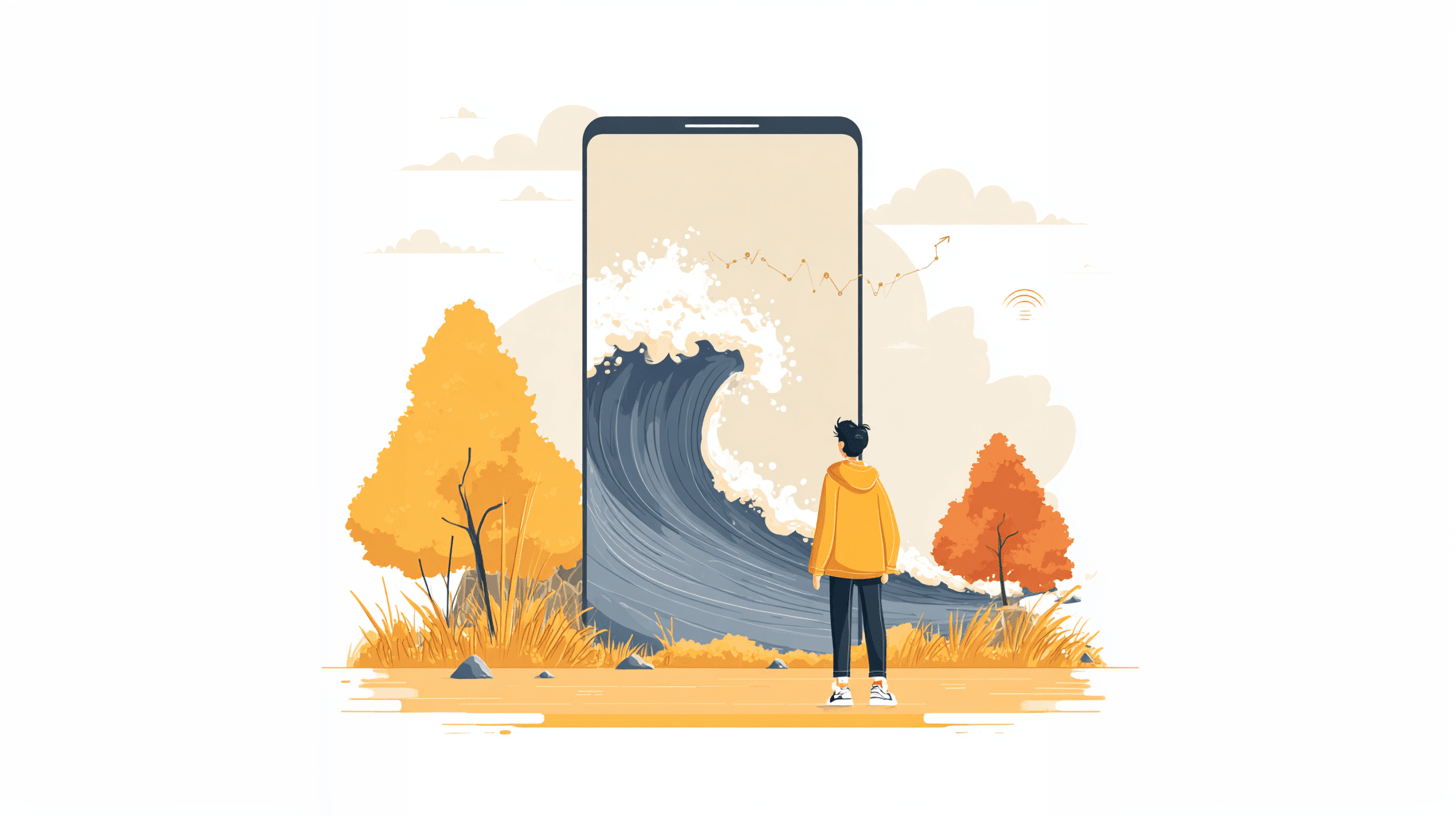Genie 3 by Google is not just another flashy demo to scroll past. It is a new kind of generative system that creates environments you can not only watch, but also move through and test. For students who like to learn by poking, probing, and repeating, that matters; a generated scene that reacts when you interact with it makes abstract ideas feel tangible. Here, we explain the model, point out its limits, and give quick, ready-to-run ideas for activities you can use right away.
What Genie 3 is
Genie 3 is a general-purpose world model that turns text prompts into short, interactive environments. Given a few words — like “stormy coastline with a low concrete railing” or “bioluminescent canyon with jellyfish” — Genie 3 produces a navigable, dynamic scene that runs at roughly 24 frames per second and 720p resolution for a few minutes of consistent interaction. That means you can move through the world, try an action, and watch believable consequences unfold.
World models are built to predict how a scene will change over time and how actions will affect that scene. Genie 3 focuses on those temporal and causal aspects: It doesn’t simply generate pretty pictures; it creates a plausible short history of a scene that you can influence. That makes it useful when the learning goal requires cause-and-effect thinking rather than just observation.
If you ever need to check whether a piece of generated text or an explanation looks machine-made, an AI detector is a quick, practical way to start — especially when your studies require clear citation of AI involvement.
How Genie 3 works
At its core, Genie 3 combines two things: a model of dynamics (how the world moves and changes) and a renderer that produces frames conditioned on actions. The model watches lots of videos and simulations to learn how things like water, smoke, light, and plants behave. When you enter a prompt and interact with the scene, it uses what’s happening now plus your actions to generate the next frames. That’s why you can explore the world live instead of watching a pre-made animation.
The practical consequence for you is that prompts define the scene, but actions define how that scene evolves for the short time it remains consistent. As Genie 3 models intuitive physics — things that behave in ways people expect — it becomes an excellent tool for building intuition, not performing precise measurements.
For students turning these generated experiments into write-ups, remember that summarizing and polishing are part of the process. A proper plagiarism checker can help ensure work is original and properly documented before submission.
Capabilities that matter
Genie 3 brings several concrete capabilities that are especially useful in a learning context.
- Interactive worlds: move, look around, and trigger events in short, consistent scenes.
- Rich natural phenomena: convincingly looking water, wind, light, and terrain interactions that react to actions.
- Creative flexibility: photorealistic scenes, stylized fiction, or mixed styles (e.g., cartoon forests or volcanic terrains).
Why this matters for studying:
- it turns static textbook diagrams into short experiments;
- it gives a safe, fast way to try scenarios that are expensive or dangerous in real life.
These capabilities let you run quick thought experiments, test simple hypotheses visually, and iterate on ideas without building a complex simulation pipeline.
Genie 3 vs. traditional simulations
Genie 3 feels like a fast way to make a playable scene from a sentence: type a prompt, and a short, interactive world model appears that you can walk through and change for a few minutes. Traditional simulations and game engines, by contrast, force you to assemble assets, tune physics parameters, and write or tweak code before anything becomes interactive — that takes time and technical skill.
The real difference for you as a student is speed and accessibility: Genie 3 gets to insight quickly, so you can sketch hypotheses and run visual experiments without an asset pipeline. But also remember the trade-offs: Genie 3 aims for believable behavior, not guaranteed numerical accuracy, while full simulators give precise, measurable outputs for experiments that need real numbers.
Use Genie 3 to explore ideas and see patterns; switch to traditional simulators when results must be reproducible, controlled, and exact.
Why Genie 3 is useful for students
If learning is a cycle of hypothesis → experiment → reflection, Genie 3 accelerates the experiment part for many topics. Here are direct ways it helps you learn.
- Visualize cause and effect: instead of imagining how a storm would reshape a shoreline, you can watch a generated storm push waves against differently shaped coasts and see where the sand might collect or erode. Observing patterns repeatedly builds intuition faster than reading a paragraph.
- Try variations fast: tweak the prompt, rerun, and compare outcomes. That iteration loop is perfect for experimentation when access to physical labs or field sites is limited.
- Make reports more concrete: a screenshot sequence or a short recorded run will make written explanations richer and clearer for graders. If text drafting still feels clumsy, run your draft through an essay grader to get quick, actionable feedback on its structure and clarity.
Beyond the convenience it provides, Genie 3 also encourages exploratory learning. Pose a question, run a few visual trials, then write a short reflection that ties your observations back to theory. That process trains you to connect experience and explanation — a core academic skill.
Practical ways of using Genie 3 to study
You don’t need to be a CS major to get useful outputs. Here are practical, low-effort ways to use Genie 3 in classwork.
- Short lab demonstrations: use a 2–3 minute generated scene to illustrate an idea before a discussion. Examples: fluid flowing around a pier, a vehicle navigating rough terrain, or light scattering in a foggy forest.
- Group mini-projects: each student group gets a prompt and writes a 500–800-word reflection comparing runs and noting what changed.
- Creative assignments: use generated settings as prompts for descriptive writing, art projects, or design briefs.
- Mock peer review: paste a short report into Genie 3 and get quick critiques, questions, and revision suggestions — then revise and submit the improved version.
When finalizing written parts, run grammar and clarity checks so the content reads as intended.
How Genie 3 differs from video generators and game engines
It helps to see Genie 3 as sitting between two familiar tools.
- Video generators: these produce fixed clips. They are great for one-off scenes but not for exploration.
- Game engines: these require models, physics parameters, and code. They give precise control but have a high setup cost.
Genie 3 blends the speed of a video generator with the interactivity of a game engine: prompts create the world, and the model responds to actions so you can explore without building assets. Unlike a passive video, you can guide what happens next, and unlike a heavy engine, you don’t need coding, 3D models, or physics libraries. Genie 3 gives flexibility without setup pain, striking a balance between creativity and usability.
The trade-offs are important:
- Genie 3 is fast to use and requires no asset pipeline.
- The tool is not a full physics simulator — outputs are mentally convincing and pedagogically useful, but not a substitute for finely controlled numerical experiments.
Use Genie 3 when the learning objective is intuition, demonstration, or rapid prototyping — not when measurement precision is required.
Designing effective study activities with Genie 3
Design tasks that match Genie 3’s strengths: something short, concrete, and observation-focused. Follow this simple recipe.
- Choose a single learning objective. Example: “Observe how slope affects rolling speed.”
- Write a focused prompt. Include the environment, the weather, and one manipulated variable.
- Prescribe actions. Give a small list of actions to try (e.g., start at three different heights, record run times).
- Require a short reflection. Compare observations to textbook expectations and note discrepancies.
A prompt-to-report checklist that keeps things clean:
- keep runs to a few minutes;
- change one variable at a time;
- record observations (screenshots, short timestamps);
- submit prompt + a short reflection.
If prompt ideas are needed for essays or follow-ups, an essay topic generator can seed creative directions that pair well with generated worlds.
Examples of short exercises you can run
These are ready-to-assign or can be tried solo. Each exercise is short, repeatable, and reflective.
- Projectile intuition. Prompt a hillside with a ramp. Try three launch heights and note where the object lands relative to the angle. Sketch expected vs observed paths and explain differences qualitatively.
- Coastal erosion mini-lab. Create two coastlines (a straight beach and a jagged bay). Run a storm prompt and observe where waves deposit or remove sand. Discuss geometry’s role.
- Ecosystem snapshot. Generate a small pond environment with visible wildlife. Observe movement patterns for three minutes, make a simple food web, and hypothesize on the effect of removing one species.
- Light and shadow study. Prompt the same object at different times of day. Note shadow length and softness; write a paragraph connecting light angle to perceived texture.
Each exercise asks for a screenshot sequence and a 300–600-word reflection.
Limitations, risks, and how to use outputs responsibly
Genie 3 is exciting, but its implementation in education should be done cautiously and with a clear understanding of its limits.
- Short consistency window. The model holds coherence for a few minutes; don’t plan multi-hour, stateful experiments in one generated environment.
- Approximate physics. Visual behavior is convincing but not a replacement for numerical simulators or lab measurements. Use outputs for patterns and intuition, not precise data.
- Hallucination and bias. If prompts are vague, the model can invent unrealistic objects or behaviors. Always pilot a prompt before assigning it to students.
Classroom safeguards:
- pilot every prompt before giving it to the class;
- ask for documentation of prompt parameters in submissions;
- grade reflections for reasoning, not raw output.
Use the model to explore possibilities, but whenever precision matters, check your observations against textbooks, experiments, or published studies.
Assessment, documentation, and academic integrity
AI-generated content raises new questions about transparency. For clear, honest work, follow these simple rules.
- Document prompts: include the exact prompt text in an appendix or submission cover sheet.
- Label AI assistance: if the generated world or text contributed substantially, state that explicitly.
- Show your reasoning: use screenshots and short annotations that show how conclusions were reached from observations.
Two quick checks before handing in any assignment:
- use a grader to tighten structure and clarity;
- run a final originality check with an AI detector or plagiarism scanner if required by course policy.
Transparent documentation protects grades and builds good research and teamwork habits.
Quick tips to make runs reproducible and useful
- Keep prompts concise and repeatable.
- Change one variable per run so comparisons are clean.
- Take notes while you watch — timestamps and short phrases beat memory.
- Use a short template for reflections (What happened? Why? What theory explains it?)
- Polish the final write-up using an AI grammar checker if needed.
A reproducible run looks like:
- A prompt (exact text).
- Two or three screenshots with timestamps.
- A 300–600-word reflection tied to theory.
That format makes grading straightforward and learning visible.
Wrapping up
Genie 3 marks a step toward making interactive, explorable worlds easy to create from text. For students, it can become a practical tool: a quick way to visualize cause and effect, test small variations, and make reports more vivid. Use the model to experiment and form ideas, then back those experiments with careful thought and clear records. When you combine both, Genie 3 changes simple reading into a repeatable learning loop. You can run quick variations by changing one thing at a time—wind strength, slope angle, or object size—and watch how the outcome shifts.
That immediate feedback helps you form better hypotheses and decide which experiments are worth following up in the real world. Remember that Genie 3 builds intuition, not precise data, so treat its scenes as starting points for deeper checks and controlled tests. Used responsibly, the tool speeds up learning, sharpens your questions, and makes classroom work more engaging and evidence-based.






